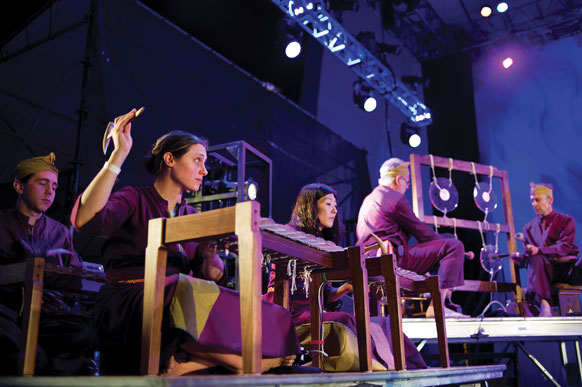Super Collider Strikes a New Note
Most musicians count on two things when they play a note: that they’ll hear the note, or some reasonable approximation of it, and that it will sound like the instrument that issued it. But in a Lincoln Center performance last August by MIT’s Balinese percussion ensemble Gamelan Galak Tika, neither expectation held true. The performance was the culmination of a project called Elek Trika, the work of a handful of skilled MIT alumni and students looking to transcend some physical and artistic limitations.

Gamelans, which originated in Indonesia more than 1,000 years ago, are made up of different types of tuned metal bars called metallophones, along with drums, gongs, and other instruments. “One of the mundane, practical goals of the project was to make [those instruments] lightweight and portable, easier to move around,” explains Alex Rigopulos ‘92, SM ‘94, a founding member of Galak Tika and CEO of Harmonix, the maker of the video game Rock Band. “But there were also artistic goals. Usually in a gamelan, the sound and tuning are fixed. We realized that if we made the instruments electronic, we could trigger any electronic sound you could imagine.”
Rigopulos, Christine Southworth ‘01, and Laurel S. Pardue ‘01, MEng ‘02, set to work, coming up with a plan to integrate electronics into a set of new instruments and commissioning furniture maker Quentin Kelley to design and build a series of sparse, lightweight wooden frames. The performers wanted the Elek Trika gamelan to include gangsas (keyed instruments played with hammers), reongs (small kettle gongs), and larger gongs—and they wanted to leave open the possibility of adding additional instruments in the future.
“We ended up with portable instruments that looked like regular gamelan instruments but were all essentially MIDI controllers,” says Pardue, a Media Lab graduate student who helped solder, code, and make circuit boards and also played in the gangsa section during the performance. “So when we played, we sent signals that went to a computer controlled by Christine—she received the input and could then change the sound.”
View exclusive images of the Gamelan Galak Tika's instruments. Watch video of the Lincoln Center performance.
“I was the brain for the gamelan,” says Southworth, who also composed Super Collider, the piece performed at Lincoln Center. “And to do that, I needed multiple scores. One version was scored for real instruments [that the group practiced on], which sounded nothing like how it would actually sound. And another score was for samples, so I knew what kind of sounds I wanted to pair with the input I received.” Samples ranged from string and tabla sounds to recordings of a Balinese vocalist that Rigopulos made as a student some 20 years ago.
Elek Trika had yet another collaborative element—they were working, from composition to performance, with members of the genre-bending Kronos Quartet, an ensemble that Pardue, Rigopulos, and Southworth had all admired for years.
“Working with Kronos was incredible,” says Southworth. “And performing in front of that many people was definitely the highlight of my life so far.”
“We pulled it off,” Pardue says. “In the end, everything worked, and worked well—even though we couldn’t always hear our own specific parts because they were coming through a set of huge speakers, and half the time we didn’t know what kind of sample Christine was using with our instrument … But Christine’s piece sounded awesome and people really liked it, and it’s all reusable!”
Indeed, Super Collider will be performed again on April 15, 2011, as part of MIT’s 150th-anniversary celebration. The performance will be “curated” by Professor Evan Ziporyn, a composer and musician, and will again feature the Kronos Quartet and Gamelan Galak Tika.
Keep Reading
Most Popular
Large language models can do jaw-dropping things. But nobody knows exactly why.
And that's a problem. Figuring it out is one of the biggest scientific puzzles of our time and a crucial step towards controlling more powerful future models.
The problem with plug-in hybrids? Their drivers.
Plug-in hybrids are often sold as a transition to EVs, but new data from Europe shows we’re still underestimating the emissions they produce.
Google DeepMind’s new generative model makes Super Mario–like games from scratch
Genie learns how to control games by watching hours and hours of video. It could help train next-gen robots too.
How scientists traced a mysterious covid case back to six toilets
When wastewater surveillance turns into a hunt for a single infected individual, the ethics get tricky.
Stay connected
Get the latest updates from
MIT Technology Review
Discover special offers, top stories, upcoming events, and more.